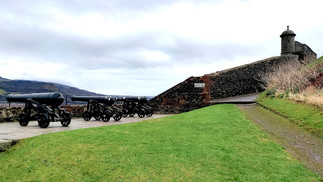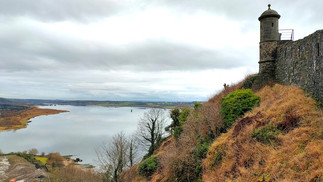Dumbarton castle visit
- lomondappletree
- Jan 17, 2024
- 3 min read
Today we’re off to Dumbarton Castle. Sitting on top of the volcanic plug known as Dumbarton the castle has a history stretching back over one and a half millennia.
Sited in its elevated position on a basalt volcanic plug, at the confluence of the River Leven and the River Clyde, the fortification has clear and commanding views in all directions.
Dating back to at least the iron age (based on finds made at the site) the first written record being in a letter by Saint Patrick in the late fifth century.
Known at that time as Alt Clut (rock of the Clyde) it was the site of many skirmishes. After being sacked by the Vikings it was not referred to again in written form until the 13th century when it served as an important royal castle named Dun Breatainn (fortress of the Britons) which morphed into Dunbarton then Dumbarton.
Interestingly the county nowadays is spelled Dunbartonshire whilst the town is named Dumbarton.
We started our visit on a dry but overcast wintery day but with good visibility to the East and west. After parking (free) at the base of the rock we made our way up the steps to the first building being the Governor’s House. Inside this Georgian mansion is the ticket office, shop and a display room for inscribed stones. The upper stories are undergoing refurbishment.
After buying our tickets, we headed along the path leading to the western most extremity known as the Bower Battery. Originally a gun battery this ledge offers superb views down the Clyde, the western side of Dumbarton and across to Port Glasgow and Gourock.
We threaded our way back towards the Governor’s mansion and headed up the steep staircase, through the Guard House and Portcullis Gate to the heart of the castle.
As we climbed the stairway we could see on our left substantial ironwork which had been recently installed to stabilise the rock face above.
On reaching the top we made our way to the building known as the French Prison – the remaining building of what was once a cluster. It is said that after the Napoleonic Wars the government considered imprisoning Napoleon Bonaparte in the castle. In the end he was sent to the island of St. Helena.
Next to the French Prison is access to the castle well. Having a good water supply was essential at time of siege.
After the French Prison we climbed the eastern summit, past the Argyll Battery and up to the Powder Magazine. The Powder Magazine is an isolated building surrounded by a second wall for safety in the event of an explosion.
Just past the Magazine is the Crane Bastion. Not great for those with vertigo as the drop down to close to sea level is severe. It was on this bastion that ropes were lowered to hoist up supplies of food, arms and ammunition directly to the top of the castle.
Back down now to the level of the French Prison and up the western side of the castle where the views are amazing. No wonder this rock became the castle it is.
There have been many visitors to the castle over the years, from King Arthur and Merlin, Scottish Kings, William Wallace and very nearly Napoleon. We enjoyed our visit thoroughly and recommend it as a good afternoon for families to visit.
More can be discovered about Dumbarton Castle here: https://www.historicenvironment.scot/visit-a-place/places/dumbarton-castle/history/































